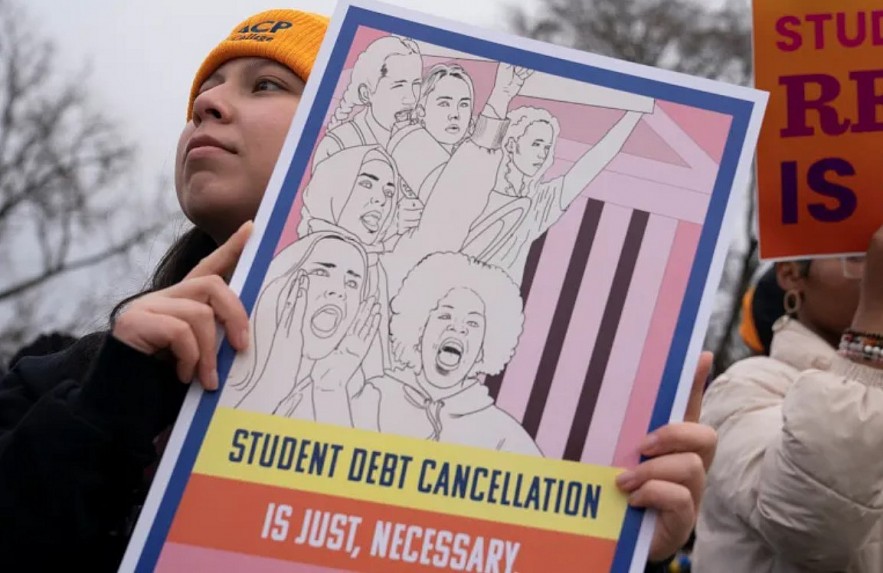Joe Biden Cancels Student Debt: What Happens Next
 Not to Pay 'Student Loans' for 2 Years, Get Forgiveness After 10 Years Not to Pay 'Student Loans' for 2 Years, Get Forgiveness After 10 Years |
 |
| Biden cancels another $4.2bn in US student loans before leaving office |
Student loan debt has long been a pressing issue in the United States, where millions of borrowers are burdened by financial obligations that hinder their economic mobility and life aspirations. President Joe Biden's administration revealed plans to forgive student loans for an additional 55,000 individuals working in public service roles.
This action, part of a broader push to reform the U.S. education and financial systems, reflects Biden’s commitment to fulfilling his campaign promise to alleviate student loan burdens.
Understanding the Public Service Loan Forgiveness Program
The PSLF program, established in 2007, was designed to assist public service workers—such as teachers, nurses, law enforcement officers, and other community servants—in managing their federal student loans. Participants in the program can have their loans forgiven after 10 years of qualifying payments while working full-time in eligible public service roles.
Historically, the program faced widespread criticism for being complex and difficult to navigate. Many borrowers who believed they were on track for forgiveness found themselves disqualified due to technicalities, miscommunication, or improper documentation. However, since 2021, the Biden administration has worked to simplify the process, removing bureaucratic barriers and making it more accessible to eligible borrowers.
The announcement on Friday brings the total number of individuals approved for debt relief under the PSLF program to nearly five million. This represents a major milestone in addressing the longstanding challenges faced by public service workers seeking financial relief.
The Broader Impact of Debt Relief
In his statement, Biden emphasized the transformative potential of these measures:
“From day one of my administration, I promised to make sure that higher education is a ticket to the middle class, not a barrier to opportunity. Because of our actions, millions of people across the country now have the breathing room to start businesses, save for retirement, and pursue life plans they had to put on hold because of the burden of student loan debt.”
This policy aims to alleviate financial stress for borrowers, enabling them to focus on personal and professional goals that contribute to the nation’s overall economic health. By targeting public service workers, the administration also highlights its support for individuals who dedicate their lives to serving their communities.
Political and Judicial Challenges
Despite its benefits, Biden’s student loan policies have faced significant opposition from Republican lawmakers and conservative groups. Critics argue that widespread debt forgiveness unfairly shifts the financial burden onto taxpayers, many of whom either did not attend college or have already repaid their loans.
The controversy surrounding Biden’s broader $430 billion debt cancellation program further underscores the contentious nature of this issue. In June, the Supreme Court struck down the plan in a 6-3 ruling, arguing that such sweeping measures require Congressional approval. This decision followed earlier roadblocks from a federal appeals court and lawsuits filed by Republican-led states, which claimed the program was excessively costly and overstepped executive authority.
Liberal justices on the Supreme Court, including Elena Kagan, Sonia Sotomayor, and Ketanji Brown Jackson, dissented vehemently. Justice Kagan accused the court of overreach, stating:
“In every respect, the court today exceeds its proper, limited role in our Nation's governance.”
While the judicial and legislative challenges have curtailed Biden’s broader student debt forgiveness agenda, the administration’s targeted relief efforts, such as the PSLF adjustments, continue to move forward.
Why This Matters: The Socioeconomic Implications
The burden of student debt has far-reaching consequences for individuals and the economy. Borrowers often delay major life milestones, such as buying homes, starting families, or pursuing entrepreneurial ventures, due to their financial obligations. By addressing this issue, Biden’s policies aim to unlock economic potential and reduce inequality.
Public service workers, in particular, often earn lower salaries compared to their counterparts in the private sector. Student loan forgiveness not only provides these workers with financial relief but also serves as an incentive for individuals to pursue careers in teaching, healthcare, law enforcement, and other essential fields.
 Top 30+ Colleges with the Lowest Student Debt in the U.S Today Top 30+ Colleges with the Lowest Student Debt in the U.S Today |
The Path Forward: What Happens Next?
While the announcement marks significant progress, the journey is far from over. The new forgiveness measures must undergo formal review by the Office of Management and Budget (OMB) before implementation. Additionally, the political landscape remains uncertain, with the potential for policy reversals depending on the outcome of future elections.
President-elect Donald Trump, for example, has expressed strong opposition to Biden’s student loan policies. On the campaign trail, he described these plans as “illegal” and “vile,” suggesting that he may seek to undo them during his term. Republican lawmakers are likely to continue opposing large-scale debt relief initiatives, framing them as fiscally irresponsible and unfair.
Conclusion
Joe Biden’s decision to cancel student debt for 55,000 additional public service workers represents a pivotal moment in his administration’s efforts to reform higher education financing. Despite facing significant political and judicial obstacles, the initiative underscores the administration’s commitment to alleviating the burden of student loans and supporting public servants.
The implications of this policy extend beyond individual borrowers, promising to strengthen public service sectors, enhance economic mobility, and contribute to a more equitable society. As the nation awaits the next developments in student loan reform, one thing remains clear: the debate over the role of government in addressing educational debt will continue to shape the American political and economic landscape for years to come.
FAQs on Joe Biden’s Student Debt Cancellation
1. What is the Public Service Loan Forgiveness (PSLF) Program?
The PSLF program was established in 2007 to forgive federal student loans for individuals working in public service roles. Eligible borrowers must make 120 qualifying payments (approximately 10 years) while employed full-time in public service jobs, such as teaching, nursing, law enforcement, or military service.
2. Who qualifies for the recent debt forgiveness announcement?
The recent announcement benefits an additional 55,000 public service workers who are participants in the PSLF program. This includes teachers, nurses, law enforcement officers, military members, and other public servants who meet the eligibility criteria.
3. What steps has the Biden administration taken to improve the PSLF program?
Since 2021, the Biden administration has implemented several changes to simplify the PSLF program:
- Addressing paperwork issues and streamlining the application process.
- Removing technical barriers that disqualified eligible borrowers.
- Launching a temporary waiver program to count previously ineligible payments toward forgiveness.
4. How many borrowers have benefited from Biden’s student debt policies so far?
As of the latest announcement, nearly five million individuals have received debt relief under the Biden administration. This includes borrowers in the PSLF program and other targeted forgiveness initiatives.
5. Why has the PSLF program been criticized in the past?
The PSLF program faced criticism for being overly complex and difficult to navigate. Many borrowers were disqualified due to technicalities, misinformation, or improper documentation, even after meeting the basic eligibility requirements.
6. What are the broader implications of this policy for borrowers?
The policy provides financial relief to borrowers, allowing them to:
- Save for retirement.
- Start businesses.
- Pursue life goals previously delayed due to student debt.
For public servants, this also serves as an incentive to continue working in essential fields that often offer lower salaries compared to private-sector jobs.
7. What are the main criticisms of Biden’s student loan forgiveness efforts?
Critics argue that student loan forgiveness:
- Transfers the financial burden to taxpayers, including those who did not attend college or have already repaid their loans.
- Bypasses Congress, raising legal concerns about executive overreach.
- Is extraordinarily expensive, potentially increasing the national deficit.
 Top 11 Universities/Colleges For Premedical Studies in the World Top 11 Universities/Colleges For Premedical Studies in the World Which university is considered to be the most prestigious educational establishment in the world for pre-medical studies? Take a look at the list that is ... |
 Top 10 American Universities That Are Best For Indian Students Top 10 American Universities That Are Best For Indian Students You have found the ideal site if you are an Indian national interested in applying to schools in the United States that welcome international students. ... |
 Top 7 Best Colleges For Asian Students In The US Top 7 Best Colleges For Asian Students In The US If you are an Asian student applying to a top university in the United States, you should read this. Discover the seven best Asian American ... |
 What Are Honey Packets: Harmless Sweetener or Hidden Danger? What Are Honey Packets: Harmless Sweetener or Hidden Danger? This article explores what honey packets are, their availability, popular brands, their actual contents, and the dangers they pose. |























